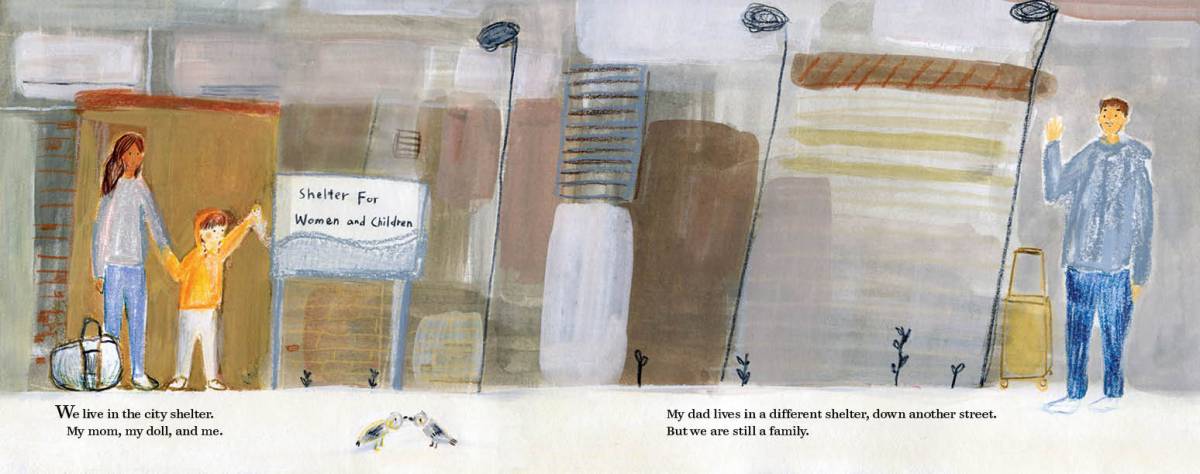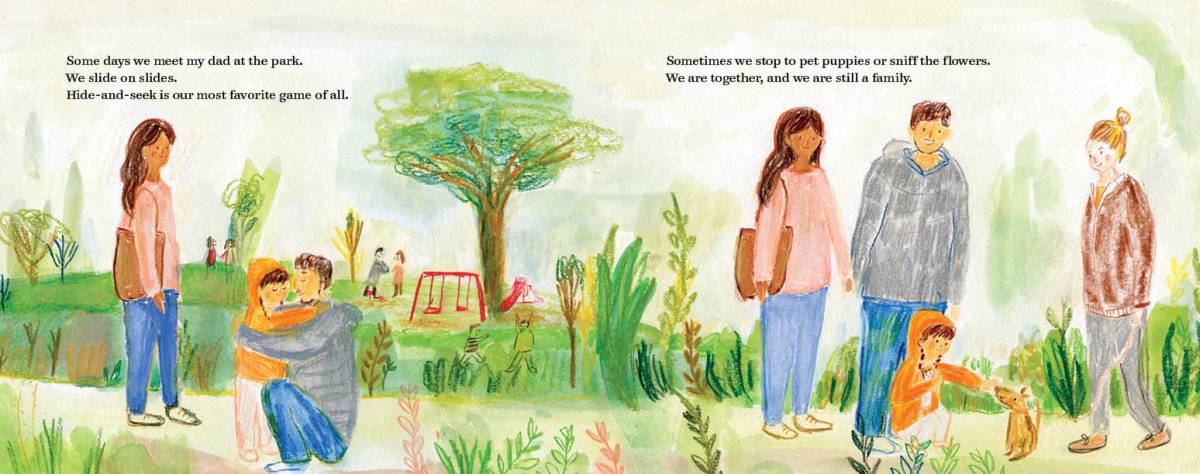
A little girl and her parents have lost their home and must live in a homeless shelter. Even worse, due to a common shelter policy, her dad must live in a men’s shelter, separated from her and her mom. Despite these circumstances, the family still finds time to be together. They meet at the park to play hide-and-seek, slide on slides, and pet puppies. While the young girl wishes for better days when her family is together again under a roof of their very own, she continues to remind herself that they’re still a family even in times of separation.
In a previous job I worked on the edge of one of the most disadvantaged communities in Canada, collaborating with preschools in an area deeply ravaged by poverty. Children living in the area witnessed the effects of poverty every day of their lives, and substance abuse, prostitution and homelessness were very real and very present factors. Many of the children I interacted with came from so-called “broken” homes, with a single parent, foster parents or grandparents as primary caregivers, and many had experienced the fall-out from incarceration or substance abuse in their immediate or extended families.
One thing I can tell you with absolute certainty, though, is that children in disadvantaged neighborhoods are still children, and their families are still families. These families might look different from the ones we typically see in portrayed in picture books, and their lives might be different, but that doesn’t make them any less valid, any less real, any less important. Families are still families, no matter their material situation, and no child should ever be made to feel embarrassed or uncomfortable because of their family makeup or living arrangements.

I can’t express how pleased I was to come across Still a Family in the library recently. Both author and illustrator handle the subject of homelessness with such gentleness, grace and respect. Homeless children are so rarely represented in children’s books, though there are so, so many families who rely on shelters every day. What makes Still a Family even more wonderful is the text’s straightforwardness and lack of judgement. The family in the story is portrayed with great empathy and respect – they are ordinary people, simply trying to do their best in a hard world. There’s no mention of why the family lives in a shelter, which allows young readers to insert their own experiences into the story, while also reinforcing the fact that as outsiders it’s really none of our business, and it’s certainly not our place to judge.

I also appreciate the fact that Still a Family has no overt moral, and no neat happy ending. The family begins the story living in separate shelters, and finishes the story still living in shelters. So many stories want to have “happy endings”, to “fix” things for their characters, but for most families struggling with poverty there are so easy fixes, and things don’t change overnight. By not changing the family’s situation, Still a Family reinforces the message that living in a shelter is nothing to be ashamed of, and that life carries on, no matter where you live.
The overall spirit of the book is one of optimism tinged with longing. This isn’t a “message” book or a “problem” book. Readers aren’t encouraged to pity the young narrator, or to be thankful that they aren’t as disadvantaged themselves. The girl’s living arrangements are not at all ideal, and she does long for something different, but primarily because she misses her father, and wants to live together as a family again. Still a Family suggests that children living in shelters can still have friends, can still have fun, can still have a life. It isn’t an ideal situation, to be sure, and I did feel that the story downplayed some of the very real dangers, stresses and inconveniences of growing up in a shelter, and perhaps glossed over some of the psychological stresses and emotional damage that can result from the lack of stability and consistency that can come with homelessness and poverty.
As the author mentions, “If you are a child living in a homeless shelter, I want you to know that you are not alone. People care, and this book was written for you.” That is such an important sentiment. Still a Family may inspire and touch the hearts of children everywhere, but it wasn’t written for them. It was written for the children whose lives it mirrors, to share their stories, and celebrate their realities and their experiences.
Hopefully we will continue to get beautiful stories like this that showcase socio-economic diversity with respect, empathy and understanding.
Still a Family
Hardcover, 32 pages
January 31, 2017 : Albert Whitman & Company
Source: Public Library
Not only is this book useful so that children who experience homelessness can achieve a feeling of community, but also it introduces other children to the concept. Hopefully this will increase empathy, inclusivity and a willingness to work together
Yes, it’s a wonderful example of a book being a mirror and a window, allowing children in similar situations to see themselves respected and acknowledged, and for other children to experience a different way of life. I hope we can get more books that tackle this all too common reality.
Thank you for doing a review and introducing me to STILL A FAMILY. The message of you matter and a family is a family no matter where you reside, is so needed today.
My thoughts exactly! With so many children living in financially-precarious situations, it’s so important that their stories be told, and with sensitivity and respect.
Great Review! I like how you referenced “happy endings” . This book is a great teaching tool for children to understand homelessness and subjects that are not talked about enough.